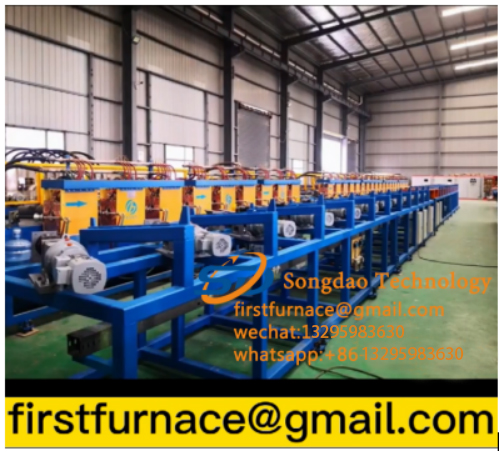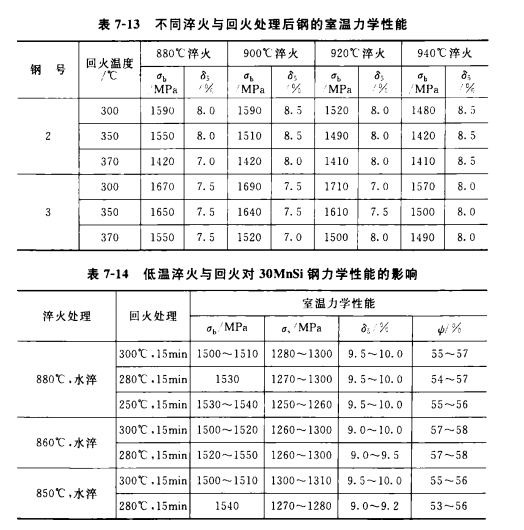- 22
- Dec
Bar quenching and tempering production line
Bar quenching and tempering production line
To
Main technical parameters of bar quenching and tempering production line:
1. Power supply system: quenching power supply + tempering power supply
2. The output per hour is 0.5-3.5 tons, and the scope of application is above ø20-ø120mm.
3. Conveying roller table: The axis of the roller table and the axis of the workpiece form an angle of 18-21°. The workpiece rotates while moving forward at a constant speed to make the heating more uniform. The roller table between the furnace bodies is made of 304 non-magnetic stainless steel and water-cooled.
4. Roller table grouping: the feeding group, the sensor group and the discharging group are independently controlled, which is conducive to continuous heating without causing a gap between the workpieces.
5. Temperature closed-loop control: both quenching and tempering adopt the American Leitai infrared thermometer closed-loop control system to accurately control the temperature.
6. Industrial computer system of quenching and tempering heat treatment equipment: real-time display of the status of working parameters at the time, and functions of workpiece parameter memory, storage, printing, fault display, alarm and so on.
7. Energy conversion: using quenching + tempering method, power consumption per ton is 280-320 degrees.
8. Human-machine interface PLC automatic intelligent control system, “one-key start” production worry-free.
Advantages of the bar quenching and tempering production line:
1. It adopts new IGBT air-cooled induction heating power supply control, low power consumption, energy saving and environmental protection, and high production efficiency.
2. The bar material quenching and tempering production line designed by Yuantuo adopts V-shaped rolls arranged diagonally in the transmission design to reduce radial runout.
3. Fast heating speed, less surface oxidation, quenching and tempering process in the rotating heating process, and the steel has good straightness and no bending after quenching and tempering.
4. After the heat treatment, the workpiece has the consistency of extremely high hardness, uniformity of microstructure, extremely high toughness and impact strength.
5. The PLC touch screen control system can record and save all the process parameters of induction hardening and tempering of the workpiece, which is convenient for you to view the historical records in the future.

棒料淬火和回火生产线
棒料坯料是指直径为30〜60mm、长度为2. 5m以下的亚共析碳素钢、低合金钢材料。棒料料是供机械制造厂加工轴类、 活塞杆、液压缸柱等使用的坯料。通常这类坯料是在电阻加热炉或 燃料加热炉内进行淬火和回火生产线。传统加热存在单位能耗高、加工余量 大、硬度不均匀、产品质量不稳定等缺点。釆用感应加热淬火和回火生产线 工艺,可以显著改善上述问题,并获得稳定的产品质量。
调质处理工艺参数的选择
作为工程机械用活塞杆、轴类和气缸柱用材料,大多为低合金 结构钢,如40Cr、42CrM。等。其感应加热调质处理的淬火、回火 温度基本相似。
- 感应加热淬火温度 40Cr钢的九3为782°C , 42CrM。的 A。为820°Co通常感应加热淬火温度在Ad以上80〜120°C即可以 完全奥氏体化。因此,淬火温度选定在900〜920°C, 40Cr可选下 限.42CrMo选上限。
- 淬火冷却条件感应加热时釆用水冷,冷却方式为喷淋式 冷却。冷却水压在0. 20〜0. 30MPa;冷却水温为30〜45°C,不应 高于50°C;冷却过程为了防止钢棒产生弯曲变形,采取钢棒在压辊控制下旋转冷却,冷却后钢棒的直线度可以控制在不大于 0. 50mm
- 感应加热回火温度轴类零件要求调质处理后具有良好的 综合力学性能,即优良的强度与韧性搭配。为此,希望得到细小的 回火索氏体组织。因此,应当采用高温回火,感应加热低合金结构 钢时的高温回火温度为600〜650℃,回火后硬度控制在26〜 32HRC,回火后钢棒空冷。
综上所述,亚共析低合金钢轴类钢坯,釆用感应加热调质处理 时,淬火加热温度可选在Ac3以上80〜120°C,回火加热采用高温 回火,其温度为600〜650°C。
- 感应加热调质处理时的加热速度选定加热速度的要点有
两点。其一,保证钢材透热,表面与中心温度基本一致,温差应小 于20°C;其二,保持生产的连续性,淬火加热、淬火冷却、回火 加热三者的速度应保持一致。表10-7给出了淬火与回火的加热时 间与使用的加热功率。
表10-7感应加热调质处理低合金钢坯料的加热条件
| 直径/mm | 长度/mm | 单重/kg | 加热H I |ii]/s | 加热温度尸 c | 使用功率/kW |
| 45 | 600 | 7. 5 | 25 | 930 | 330 |
| 600 | 210 | ||||
| 50 | 800 | 13 | 43 | 930 | 330 |
| 600 | 210 | ||||
| 55 | 780 | 15 | 50 | 930 | 330 |
| 600 | 220 |
PC钢材淬火和回火生产线温度的选择
淬火温度的选择依据下列几点,通过综合考虑之后加以确定。
(1)参照钢的临界点Ac3来选择淬火温度亚共析低合金钢的 淬火加热温度为Ac3以上30〜50°C ,由于随加热速度的 增加,Ac3点上移,其淬火加热温度将上移20〜50℃。PC钢材淬火和回火生产线淬火处理时,不仅只要求通过淬火实现奥氏体化,更重要的 目的是希望获得细小的晶粒和淬火马氏体组织,以便回火后得到具 有高的屈服强度、高屈强比和一定塑性的回火屈氏体组织,有利于 提高钢材抗应力松弛性能。为了达到以上目的,应当尽量降低PC 钢材的淬火温度。为此,PC钢材淬火和回火生产线淬火温度应在Ae以上 60〜100°C, PC 钢的 A3见表 7-12。
| 表7-12 PC钢的临界点温度(参考值) °C | ||
| 钢号 | A” | |
| 30Mn | 734 | 812 |
| 30SiMn | 740 | 840 |
| 30MnB | 732 | 847 |
| 35SiMn | 750 | 830 |
 根据产品力学性能选择淬火温度PC钢材产品对力学性 能的要求有其自己的特点。它要求钢材具有高的屈服强度(2 1275MPa)、高的屈强比(20.05)和一定的塑性(25%)、良好 的抗应力松弛性能,这些力学性能指标保证了 PC钢材的使用寿命 长期稳定。表7-13和表7-14给岀了不同传统加热淬火与回火处理 后,典型PC钢材的室温力学性能。表中所列的数据为分析淬火温 度与力学性能的关系,提供了科学的依据。这些数据可提供下列 依据。
根据产品力学性能选择淬火温度PC钢材产品对力学性 能的要求有其自己的特点。它要求钢材具有高的屈服强度(2 1275MPa)、高的屈强比(20.05)和一定的塑性(25%)、良好 的抗应力松弛性能,这些力学性能指标保证了 PC钢材的使用寿命 长期稳定。表7-13和表7-14给岀了不同传统加热淬火与回火处理 后,典型PC钢材的室温力学性能。表中所列的数据为分析淬火温 度与力学性能的关系,提供了科学的依据。这些数据可提供下列 依据。
①随淬火温度的提高,钢的强度下降塑性升高。因此,提高 淬火温度会降低屈服强度和屈强比,对提高抗应力松弛性能产生不 良影响。
②适当降低淬火温度(860〜900°C).可以保持较高的屈服强 度和高的屈强比。低的淬火温度将有利于改善钢材的表面质量、节 省能源,还能保持良好的抗应力松弛性能。
综上所述,PC钢材为了得到细小奥氏体晶粒和全部为淬火马 氏体组织,其合适的淬火和回火生产线淬火温度范围应在A*以上约80℃。 对于硅镒系PC钢而言,淬火温度为900〜950℃。相当于传统加热 时880〜920°C淬火温度。
